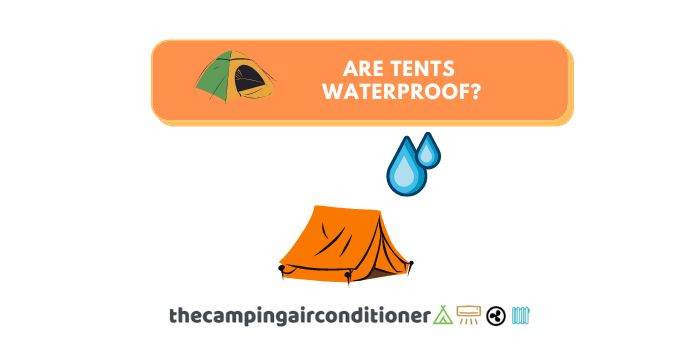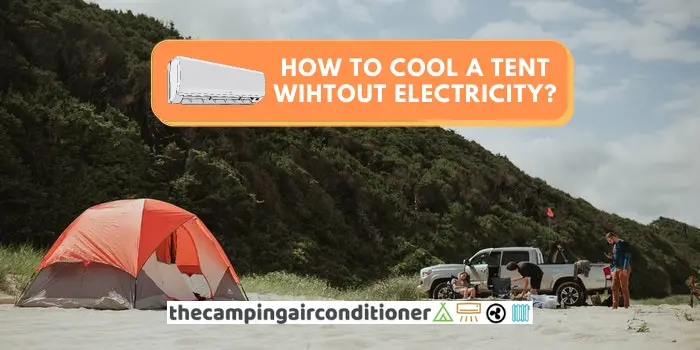Well, this is an important question without a simple answer. Most manufacturers are unclear about their tent’s waterproofing, leaving an outdoor lover with many unanswered questions. They mainly focus on coatings and waterproof ratings, leaving out important information on waterproofing.
So, are all tents waterproof? No, most tents are designed to be water-resistant rather than fully waterproof. An average tent can easily handle a typical rainstorm, but it may leak in heavy wind/rain.
For your tent to be considered waterproof in most outdoor conditions, you will have to spend more to buy a tent with a 3000mm HH (Hydrostatic Head) rating – the HH is a measure that refers to how waterproof a fabric is (more on it below).
However, you probably don’t need to purchase an overly expensive tent to serve your purpose, as you might not need a completely waterproof tent. Most campers are lucky enough to find an affordable tent and use it with powerful waterproofing spray and seam sealant.
Keep reading to know more about how you can keep your tent waterproof. It is a long article, so feel free to read any section you want.

How do you check if your tent is waterproof?
It is always good to know how much rain can your tent withstand.
Before you take your gear for your next camping trip, we recommend you do a dry run to check its waterproofness – After all, it is better to be disappointed in your backyard than in the wilderness.
You have to inspect seams, walls, floor, and stitches. Even the tiniest tear or hole will allow rain to get into the tent, hence the need for a thorough inspection.
Before you take your tent outdoors, pitch the tent, take the hosepipe out, soak the seams well, and examine the following parts of your new tent:
#1 - Seams
Checking the seams is essential as they determine if your tent will last even a single night in the rain.
They are the most vulnerable parts of a tent because they can easily create holes and gaps, and must be completely sealed to make sure the tent is waterproof. There are different types of tent seams, including:
Taped Seams
This does not mean you take the tape into your house and put it on the seams – The tape would come off easily!
Instead, manufacturers use pressure and heat to melt the tape into the fabrics. Taped seams are the best ways to ensure it is waterproof and will withstand rainy weather. Manufacturers tapes both interior and exterior seams for maximum protection against water.
Welded Seams
Welded seams refer to when 2 pieces of fabric are welded together through pressure and heat- there are no stitching or holes in this procedure, providing excellent protection against water (as long as the weld stays intact).
Most of the time, welded seams are commonly used to seal tent floors.
Inverted Seams
Inverted seams refer to when two fabric pieces are sewn together in the tent to ensure there are no gaps that may attract rainwater. They don’t come apart easily and are durable.
#2 - Sides
All tents have doors and windows, and if they are left open, they allow water to enter. Purchase a well-designed tent that will keep the rain away from the inside.
Some tents, such as The Wenzel Klondike 8-Person, have screen room areas that allow better air circulation. However, you might want to close or retract this area to avoid water inflow during rainy days.
#3 - Stitching
All tents are stitched, and every stitch is a small hole that should be examined carefully. Most tent designs overlap the material and reduce the amount of stitching to minimise the potential sources of leaks.
#4 - Hydrostatic Head
Hydrostatic (HH) measures the waterproof level of your tent’s fabric.
This measure (also known as waterhead) is gauged in milimetres and refers to how high a column of water standing on the fabric would have to be before the water would pass through the fabric (and leak inside your tent, for example).
You may find highly water-resistant fabrics with a HH of 30,000mm, which means the water column would have to be 30 metres high before the water goes through the material!
Basic tents have from 1000mm to 2000mm HH rating, and they are suitable for use during light rain. However, if heavy downpour is forecast, you might have problems with them.
What is a Good Waterhead Rating for a Tent?
As discussed above, Waterhead and hydrostatic head mean the same thing. After our thorough research and own experience in camping, we noted the following guidelines:
- From 0 to 1000mm – The tent is barely water-resistant and will only protect you from light rain for a short period of time (a couple of minutes.)
- From 1000mm – to 2000mm – These tents are water-resistant, and you can enjoy some protection from wet weather (it will fit almost all camping conditions, and you should be fine). Ciays camping tent (below) fits up to 4 people and comes with a 1200mm waterhead rating at an affordable price.
- Waterhead - 1200mm
- Great Value For Money
- Rainfly included
- Lightweight
- From 2000mm to 5000mm – These tents are highly water-resistant and will provide you with excellent protection against rainfall. A good example is Nature Hike Cloud up (below), which offers an impressive 4,000mm protection.
- Excellent waterproofness - 4000mm
- Extremely High quality product
- Quick and easy set up
- Double Layer (Nylon-made)
- From 5000mm and beyond – These can be considered waterproof tents. The fabrics can support a high load of rain without letting water pass through it – it might be your choice if you plan to camp in tropical climates or mountains, where rains are known to have high intensity and occur daily.
Is a higher waterhead rating better for a tent?
Well, not necessarily. While the higher the hydrostatic head, the more water-resistant your gear will be, everything comes at a cost.
Excess waterproof coating and protection may lead to a heavier tent and a decreased flexibility in your tent. This means that your gear will have less tear strength and can be easily damaged.
Therefore, you need to find a sweet spot between water resistance and fabric strength. We would recommend tents from 1,000mm to 3,000mm unless you plan to camp in extremely wet conditions.
To improve water protection, you can also use a rainfly, and you can also use waterproofing sprays.
How to waterproof a tent?
Waterproofing a tent is vital if you want to have a good camping trip to be enjoyable. Sometimes, the process is easier and cheap than investing in a new tent.
First, you need to check for any issues with the tent thoroughly. Follow the following steps:
- Stake out the tent in a place with good ventilation and lighting
- Check if the rainfly has any holes. Even a 1mm tiny hole can make your tent wet in case of heavy rains.
- Then, remove the rainfly to check the seams and walls. Look whether the seams are protected, and check for holes or peeling.
- Examine the doors and zippers. Ensure there is no mesh exposed, and the zipper should be protected.
- Check for any coating that is peeling and any slits or holes.
- Lastly, double-check the seams inside the tent again to thoroughly look for holes in the floor.
If the waterproof coating starts to separate from the walls or floors, it would be good to purchase a new tent. If the tent doesn’t have severe problems, here is how you can waterproof your tent:
Step 1 - Sealing seams
To seal the seams, you will require a seam sealer, rags, and a small brush that comes with the sealer. Some options, such as the kit GEAR AID Seam Grip WP Waterproof Sealant already comes with everything that you need.
Step 2 - Patching holes
If your tent has any holes, your tent will leak even when the rain is light. Patching holes involves the following steps:
- Clean the areas around the hole
- Cut a precise repair tape; try rounding the edges so that it doesn’t peel off easily
- Tape it onto the tent, and you are done.
There are multiple patching kits available these days. We recommend the TEAR-AID Fabric Repair Kit Gold Box since it’s compatible with almost all fabrics.
Step 3 - Spray the tent with durable repellant
The market has different water repellants for large or small tents.
A repellant like Kiwi Camp Dry Water Repellant (below) is ideal if you want something protective and durable for your tent. However, it is still important to seal the seams and patch the holes separately because they are highly vulnerable spots.
The video below further details how to waterproof your tent.
Can a Tent lose its waterproofing?
Yes, it can, even though it is not so common. This is because the water-resistant coating applied to it might tear away with excessive sun exposure or inappropriate storage.
Therefore, it is important to check your tent’s waterproofness and re-coat it every one or two years or after every six months. This will strengthen the coating and prevent it from wearing.
How do I keep my tent dry in the rain?
Keeping your tent dry in the rain will provide many benefits. Keeping dry will keep you, and your gear protected so that you won’t have to purchase new ones now and then.
When camping in the rain, the interior should be well protected to enhance your comfort. The exterior already has power water-resistant properties that will prevent leakage. Here are important tips that will help your tent dry in the rain:
- Ensure the doors, windows, and ventilation points are closed.
- Purchase a tent with a waterproof rain shield or rainfly
- Open windows when it is not raining, especially during the day. This will ensure the moisture released by breathing is not trapped inside (avoiding condensation)
- Invest in a quality water repellant that will protect the tent’s surface
- Pitch your tent on high ground where water is running off
- Get a seam sealant to get rid of weak spots that will let moisture in
- Avoid setting up too close to streams and rivers.
Conclusion
As you have seen, tents are actually more water-resistant than waterproof, and tent fabrics are classified according to the hydrostatic head.
Overall, tents with more than Waterhead ratings above 1,000m should be sufficient to protect you from light rain. If you are about to buy a new tent, always check for its waterproof rating and floors, seams and coatings.
Generally speaking, floors are areas that should have the highest protection, given they are constantly under pressure (your weight pressures the bottom of your tent against the soil and facilitates water penetration)
If you already have a tent, it might be good to undertake a wet test before heading on the next trip. Be mindful that water-resistant coats might tear away due to sun exposure and decrease their ability to retain water.
Therefore, ensure that your tent is re-waterproofed every now and then (6 months to 2 years) to ensure proper protection. You can use sprays, and seam sealers to help you on doing it.








